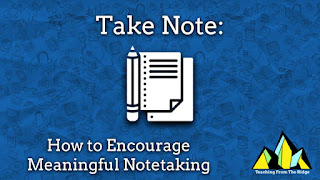 Students take a lot of notes in middle school and high school.
Students take a lot of notes in middle school and high school.
I know-- I’ve collected and actually kept the binders full of notes I took from my high school years, and as a teacher, I’ve passed out thousands of pages of notes and outlines for students to use.But let’s take a step back. How should our students take notes? And why?
1) Help students understand why we take notes.
Notes are for recall, not learning. I didn’t really understand this until my 5th year of teaching, but notes are not for learning a topic or a skill. The learning happens through the activity, mini-lesson, reading, etc, that students are doing. Instead, notes should be a meaningful retrieval device for students to use later to “jog” their memory. For more on this, check out Patrice Bain’s and Pooja Agarwahl’s book, Powerful Teaching.And if we’re trying to train “retrieval”, then I recommend:
- Have students do a “Pause & Listen”.
- Let Student’s Notes Be Personal.
2) Provide a variety of ways for students to take notes.
Note-taking thrives or dies on its flexibility to accommodate all types of learners and thinking, so as much as possible, give students a variety of ways to jot down their thinking. I provide students four ways to take notes on their own in my class:- Take their own on paper.
- Use a Cornell-style, scaffolded “fill-in-the-blank” page.
- Use a Cornell-style, “open-ended page”.
- Take their own on an app of their choice (more on this down below).
(And please feel free to steal those templates!)
Of course, every teacher should feel free to provide whatever kind of scale of options that is most appropriate for their students’ particular needs. For instance, in my upper-level Dual Credit U.S. History class, the “fill-in-the-blank” page isn’t available (unless a particular IEP, 504, or some other accommodation needs to be met).
3) Remove scaffolding over time.
As students get more familiar with the mini-lessons, activites, or readings present in your classroom, start gently pulling away support they’ve relied on. It’s a lot like training wheels on a bike. For most riders, training wheels are a necessary part of learning how to balance, manage speed, turn, and more. But eventually, the training wheels get in the way of riding faster. Having this conversation with students can be difficult-- I’ve had many a conversation about taking small steps towards more independent note-taking. As an example, I’ve had students add one “open box” at a time until they completely transitioned out of the “fill-in-the-blank” style.4) Notes should hit multiple types of thinking and processing: visual, kinesthetic, interpersonal, intrapersonal, metacognition, and more.
The more that I can get my students to think, write, speak, share, draw, and do a whole variety of things on notes, the more meaningful recall devices they become. Check out all of the different kinds of activities I have students complete on my versions of notes:
Notes don’t have to be boring! As they say, variety is the spice of life!
5) Note-taking apps should empower student recall and meaningful learning, not encumber them.
As soon as the tool gets in the way of learning happen, "ditch it" (pun very intended). Anyways, Here's some app ideas. Each has their own particular strengths and weaknesses, so I generally let students choose the one that works best for them (if they're so inclined).
Happy Noting!
Nate
Personal, Purposeful, Professional Development
We've traveled across the nation since 2018 speaking at conferences like ISTE, writing blogs for OnCUE and tech companies, and publishing podcasts for beginning teachers.
No matter the kind of PD you have in mind, we'll design a powerful experience customized for you and your needs. We promote solid, evidence-based practices and strive to give teachers tangible ways to change the lives of their students.

Informative post indeed, I’ve being in and out reading posts regularly. as we provide Online Behaviour Management Training at affordable prices. for more info visit our website.
ReplyDelete